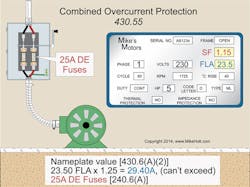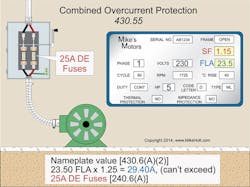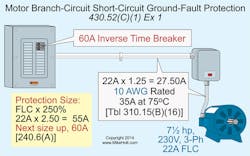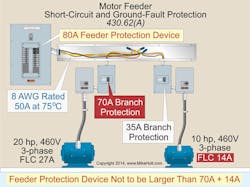In Part 1, we saw why we must separate overload protection from fault and short circuit protection for motor circuits. But correctly sizing these different devices can be confusing. And if you follow the rules for one while doing the other, you’re likely to burn something up.
When sizing motor overload protection devices (OPDs), two numbers you don’t use for other types of circuits are vitally important.
1. You must know the motor nameplate service factor (SF). An SF of 1.15 means the motor can periodically operate at 115% of its rated horsepower.
2. When you size motor OPDs, you use the motor nameplate current rating (FLA). This differs from the Full Load Current (FLC) from the NEC tables that you use for sizing overcurrent protection devices (OCPDs) for motor branch circuits.
Supersize me
For motors with an SF of 1.15 or more, size the OPD no more than 125% of the FLA [430.6(A)(2)]. If your OPDs are fuses, you can’t exceed the values of Sec. 430.32(A)(1). That means you must round down to the next smaller fuse. Standard fuse sizes are listed in Sec. 240.6(A).
But what if the motor can’t start without blowing the OPD? If the sensing element, setting, or sizing of the motor OPD isn’t sufficient to allow the motor to start (or carry the load), you can increase the OPD size or setting. But the limit is:
• 140% for motors with a marked SF of 1.15 or greater [430.32(C)].
• 130% for motors with a SF of less than 1.15 and a marked temperature rise over 40°C [430.32(C)].
• 125% for motors with a nameplate temperature rise rating not over 40°C.
A motor with a nameplate temperature rise of 40°C means the motor is designed so that it won’t heat up more than 40°C above its rated ambient temperature when operated at its rated load and voltage.
Combo OCPD and OPD
As noted earlier, for motor circuits, we separate the functions of overload protection from those of protection against short circuits and faults. But with short-time, intermittent, periodic, or varying-duty motors, you can combine these functions in the OCPD [430.33]. The catch here is the rating or setting of the OCPD can’t exceed the values in Table 430.52. And, of course, the controls or the nature of the application must ensure the motor can’t operate continuously under any conditions of use.
In many cases, the inrush isn’t enough to create the problems that require the separation of OCP and OCPD, even if you do have a continuous-duty motor. Then you can use a single OCPD to protect a motor against overload, short circuit, and ground faults. But you must size it to the overload requirements in Sec. 430.32 [430.55].
Here’s an example to help illustrate the concepts we’ve discussed thus far.
Question: What size dual-element fuse is permitted to protect a 5-hp, 230V, single-phase motor with a service factor of 1.15 and a nameplate current rating of 23.50A from overloads and from short circuits and ground faults (Fig. 1)?
Size the overload protection per Sec. 430.32(A)(1) and Sec. 430.55.
23.50A × 1.25 = 29.40A
Based on the standard ampere ratings of fuses shown in Sec. 240.6(A), you should use a 25A fuse to protect the motor.
In this example, we used a small motor. It doesn’t draw much current, so the inrush and heat are also on that small scale. But this ability to combine isn’t limited to small motors. The separation of OPD and OCDP accommodates the inrush that occurs when you start the motor across the line. What if you use a soft starter or a variable-frequency drive (VFD) with soft-start function?
Soft starters and VFDs provide the OPD function, so you don’t need to size OPDs in a separate starter. More importantly, they dramatically reduce inrush. With one of these devices inserted between the supply and the motor, your branch circuit OCPD now sees a very different load. Because of this, the manufacturer provides OCPD sizing instructions so you can correctly size the OCPD [430.130(A)(2)].
Branch circuit short circuit and ground fault protection
A branch circuit OCPD protects the motor, motor control apparatus, and conductors against short circuits or ground faults. But it doesn’t protect them against overload [430.51]; that’s the job of the OPD (except as noted earlier). The branch circuit OCPD must able to carry the motor’s starting current [430.52(B)]. You can size that OCPD no greater than the percentages listed in Table 430.52 [430.52(C)].
What if the size OCPD you need doesn’t correspond with the standard OCPD ratings listed in Sec. 240.6(A)? In that case, you can apply the “next size up rule” and use the next higher OCPD rating [430.52(C)(1) Ex 1].
Here’s an example to illustrate the calculations you must make when choosing the proper protection device for a motor.
Question: What size conductor and inverse time circuit breaker are required for a 7½ hp, 230V, 3-phase motor with terminals rated 75°C (Fig. 2)?
(a) 10 AWG, 50A breaker
(b) 10 AWG, 60A breaker
(c) 8 AWG, 70A breaker
(d) 8 AWG, 80A breaker
Step 1: Determine the required branch-circuit conductor, 125% of FLC [Table 310.15(B)(16), Sec. 430.22, and Table 430.250]: 22A × 1.25 = 27.50A, rated 35A at 75°C
Step 2: Determine the branch circuit protection, 250% of FLC [240.6(A), 430.52(C)(1) Exception 1, and Table 430.250]: 22A × 2.50 = 55A, next size up = 60A
From the options given, the correct answer is: (b) 10 AWG, 60A breaker.
Feeder OCPDs
How you size OCPDs for a motor feeder depends upon whether it supplies a motor load and other loads [430.62] or only a motor load [430.61]. Let’s look at “motor loads only” first.
Size the OCPD not more than the largest rating of the branch circuit OCPD for any motor, plus the sum of the full-load currents of the other motors in the group.
Question: What size feeder protection and conductors are required for these two motors with terminals rated 75°C? (Fig. 3)
Motor 1: 10 hp, 460V, 3-phase:
FLC = 14A [Table 430.250]
Motor 2: 20 hp, 460V, 3-phase:
FLC = 27A [Table 430.250]
(a) 70A breaker, 4 AWG
(b) 80A breaker, 8 AWG
(c) 90A breaker, 3 AWG
(d) 100A breaker, 3 AWG
First, size the feeder protection [430.62(A)] device so it’s no greater than the largest branch-circuit OCPD, plus the other motors’ FLC.
Step 1: Determine the largest branch-circuit OCPD [430.52(C)(1) Ex].
10 hp motor = 14A × 2.50 = 35A
20 hp motor = 27A × 2.50 = 68,
next size up = 70A
Step 2: Determine the proper size feeder protection.
Not more than 70A + 14A = 84A, next size down = 80A [240.6(A)]
The “next size up protection” rule for branch circuits [430.52(C)(1) Ex 1] doesn’t apply to the motor feeder OCPD rating.
Now it’s time to calculate the feeder conductor size. The feeder conductor size is based on 125% of the FLC of the highest rated motor in the group plus 100% of all other motor FLCs on the same phase [430.24].
(27A × 1.25) + 14A = 48A [110.14(C) and Table 310.15(B)(16)]
A check of the Table reveals that an 8 AWG conductor is rated 50A at 75°C. Therefore, the correct answer is: b) 80A breaker, 8 AWG conductor
If the circuit contains other loads in addition to motors, the OCPD rating must not be less than that required for the sum of the other loads plus the rating permitted by:
• 430.62, for two or more motors.
• 430.52, for a single motor
• 440.22, for a single hermetic motor.
What about hermetic motors? Article 440 applies to the hermetic motors that drive the compressors of air-conditioning and refrigeration equipment. These motors are of a special construction. Your typical industrial pump motor has its own housing and you bolt it to a pedestal. There’s a coupling from the motor to the pump unit. These are clearly separate structures.
But a hermetic motor doesn’t have its own housing. It’s enclosed in the same housing as the refrigerant. This motor thus has different heat dissipation capability from a non-hermetic motor. For that reason, you apply Art. 440 requirements when sizing OPDs for these motors and OCPDs for systems with these motors.
Avoiding mistakes
Article 430 can be confusing because provisions for motor circuits differ from general rules. The overload protection for motors is (usually) treated separately from short circuit and ground fault protection. Motor circuits must accommodate increased starting current and still provide satisfactory running protection. For this reason, the overcurrent protection rules you learned in Art. 240 don’t apply to motor circuits.
A common mistake made in motor circuits is the use of the motor nameplate current for calculations that should be made using the full-load current from the Art. 430 tables. Use the nameplate FLA only used for overload protection. Use Tables 430.248, 430.249, and 430.250 for sizing conductors, short circuit and ground fault protection, and disconnect switches.
Holt is the owner of Mike Holt Enterprises, Inc., Leesburg, Fla. He can be reached at www.mikeholt.com.
About the Author

Mike Holt
Mike Holt is the owner of Mike Holt Enterprises (www.MikeHolt.com), one of the largest electrical publishers in the United States. He earned a master's degree in the Business Administration Program (MBA) from the University of Miami. He earned his reputation as a National Electrical Code (NEC) expert by working his way up through the electrical trade. Formally a construction editor for two different trade publications, Mike started his career as an apprentice electrician and eventually became a master electrician, an electrical inspector, a contractor, and an educator. Mike has taught more than 1,000 classes on 30 different electrical-related subjects — ranging from alarm installations to exam preparation and voltage drop calculations. He continues to produce seminars, videos, books, and online training for the trade as well as contribute monthly Code content to EC&M magazine.



